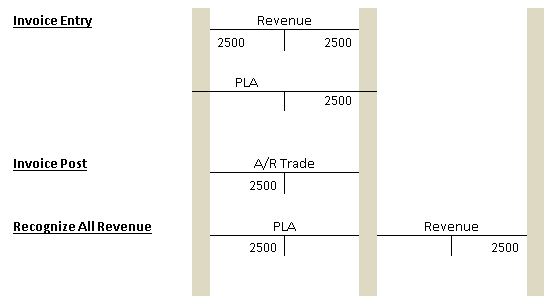35 Overview to Revenue Recognition (Release A9.3 Update)
Business processes and financial standards outline when you can recognize revenue for amounts you bill to customers. You cannot recognize revenue for the amounts you bill or Cost of Goods Sold (COGS) amounts associated with the billing amount until the performance obligation to the customer is satisfied.
Every company and each of their customers must agree to the terms that constitute the completion of a performance obligation. Performance obligations can be satisfied in different ways and at different times. Examples of this include:
-
Retail – the customer takes possession of the goods and is billed at the time of the sale. The performance obligation is complete and revenue is recognized at billing.
-
Services – services are completed for a customer and they sign off on the work. The performance obligation is complete at the time the customer signs off on the work and revenue is recognized at billing.
-
Distribution – goods are shipped to a customer and they are billed at the same time. The performance obligation is not complete until the customer takes possession of the goods and accepts them as complete. You cannot recognize revenue at the time of billing. The system accounts for the billing amount as a performance liability. Once the customer takes possession and accepts the goods, the revenue is recognized and the performance liability cleared. Any COGS amounts associated with the billing amount is also considered a performance liability and can only be recognized once the performance obligation is complete.
-
Construction – in some industries, such as construction, customers are billed for portions of the contract that are complete or for time and materials as they occur. The recognition of the revenue is tied to the terms of the contract for each type of billing line. Some billing lines can be recognized immediately and others might need to be considered a performance liability until other terms have been met.
As illustrated in the previous examples, you cannot recognize revenue or COGS on all transactions at the time of billing. In these cases, transactions must be processed separately using performance liability accounting and revenue and COGS are recognized upon completion of the obligation.
JD Edwards World includes processes for performance liability accounting in Service Billing, Contract Billing , Sales Order Management, and Accounts Receivable (A/R).
This overview includes the following topics:
35.1 Overview to Performance Liability Accounting
When you bill a customer, before the performance obligation is met, the system processes this using PLA. The system records the revenue and COGS amounts (if applicable) in the PLA rather than the revenue and COGS accounts. The system uses the PLA and COGS PLA as intermediate accounts that hold the amounts until you recognize them.
Upon recognition of the revenue and COGS, the system debits the PLAs for the original revenue and COGS amounts and credits the revenue and COGS accounts with the amounts recognized.
JD Edwards World uses Automatic Accounting Instructions (AAIs) to determine which accounts to use for the performance liability and performance liability adjustment accounts.
35.2 Tables Used in Revenue Recognition
The system uses the following tables to store information about each invoice in the revenue recognition process:
| Table | Description |
|---|---|
| A/R Revenue Recognition - Invoices (F03116) | The system stores all revenue recognition information related to the invoice pay items, such as the domestic or foreign revenue recognition amounts, the revenue recognition status, the recognition reason code, the revenue recognition date, and the eligible for recognition date. |
| A/R Revenue Recognition - Invoice Distribution (F03117) | The system stores all revenue recognition information related to the distribution for the invoice, such as domestic or foreign revenue recognition amounts, the recognition reason code, and the revenue recognition date. The system also stores the G/L distribution information for the invoice. |
| Account Ledger (F0911) | Based on the values in the F03117 table, the system creates entries in an FB journal entry to maintain the actual revenue and Performance Liability Account (PLA) in the F0911 table. |
| A/R Ledger (F0311) | When you enter an invoice, the system updates the Revenue Recognition Indicator field in the F0311 table with a 1 (yes) to identify those invoices that are in the revenue recognition process. The field is blank for invoices not in the revenue recognition process. |
| Purge - A/R Revenue Recognition - Invoices (F03116P) | Stores the purged invoice data from the F03116. |
| Purge - A/R Revenue Recognition - Invoice Distribution (F03117P) | Stores the purged distribution data from the F03117. |
35.3 Revenue Recognition Example
Following is an example of G/L accounting entries that the system creates for an invoice as it moves from invoice entry through the revenue recognition process.
-
When you enter the invoice, the system creates the revenue amount in the F0911. It also creates a FASB Revenue Recognition (FB) journal entry that removes the revenue amount and creates a PLA entry for the amount of the invoice.
-
When you post the invoice, the system creates the corresponding A/R Trade account entry.
-
When you recognize revenue for the invoice:
-
The system debits the PLA for the amount you recognize.
-
The system credits the revenue account with the amount you recognize.
-
Figure 35-1 T accounts for recognizing all revenu

Description of ''Figure 35-1 T accounts for recognizing all revenu''